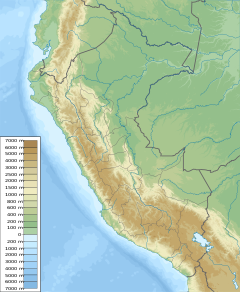Huascarán National Park
| Huascarán National Park | ||
|---|---|---|
| Nevado Huascarán | ||
|
|
||
| Location: | Ancash , Peru | |
| Surface: | 3400 km² | |
| Founding: | July 1, 1975 | |
| Huascarán National Park | ||
| Huascarán National Park | ||
| Huascarán National Park | ||
The Huascarán National Park covers the Andes area beyond 4000 m in the Cordillera Blanca in Peru . The only exception is the Champara region. It has an area of 3400 km². In the national park is the highest mountain in Peru at 6768 m and the fourth highest mountain in South America , which bears the name Nevado Huascarán .
Flora and fauna
One of the rarest plants on earth grows here. The Puya raimondii from the bromeliad family grows up to 10 meters high and can reach an age of 100 years. Notable animal species found in the national park are the spectacled bear and the Andean condor . The national park and its mountain range is a magnet for many mountaineers from all over the world and the destination of numerous high expeditions , the starting point of which is usually the city of Huaraz .
National park
The establishment of the national park serves to preserve flora , fauna , the beautiful landscape and scientific research. By controlling the access and paying an entrance fee, the annually increasing flow of mountaineers is to be regulated in order to prevent damage to the sensitive nature.
history
As early as the 1960s, the Peruvian mountaineer César Morales Arnao called for the area to protect the snow-covered mountain peaks in the Cordillera Blanca and to preserve the original landscape. But it was not until July 1, 1975 that the area was declared a national park in accordance with statutory ordinance N ° 0622-75-AG. In 1985, UNESCO declared the national park a world heritage site .





